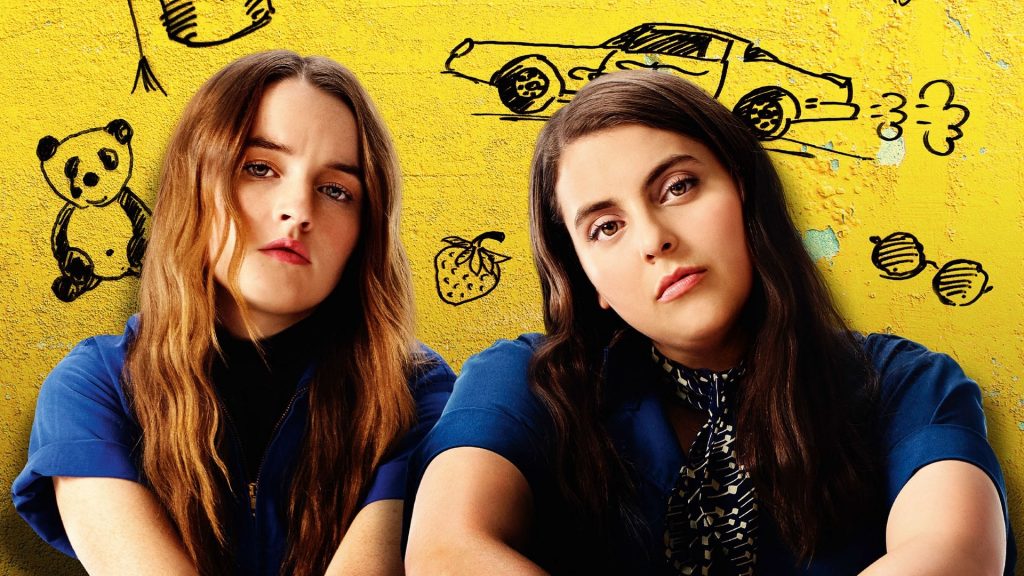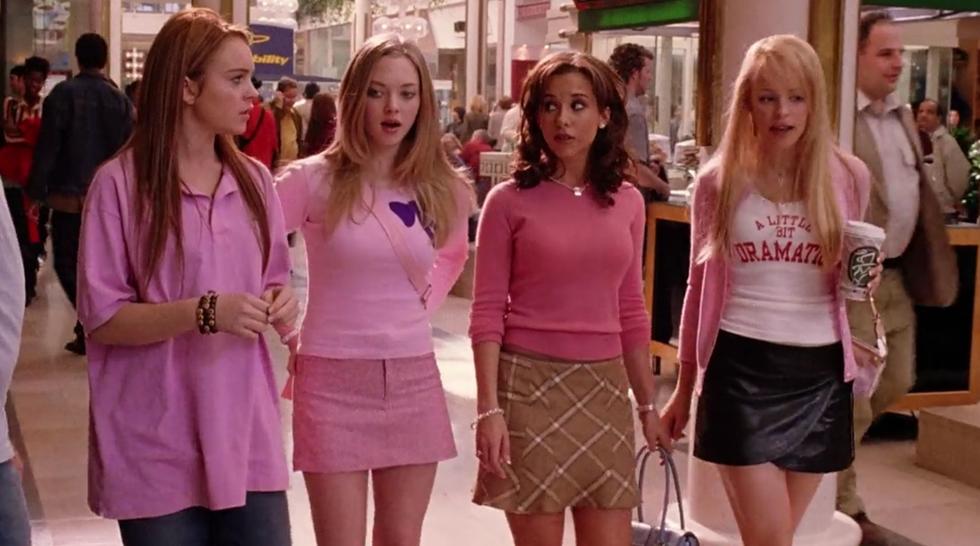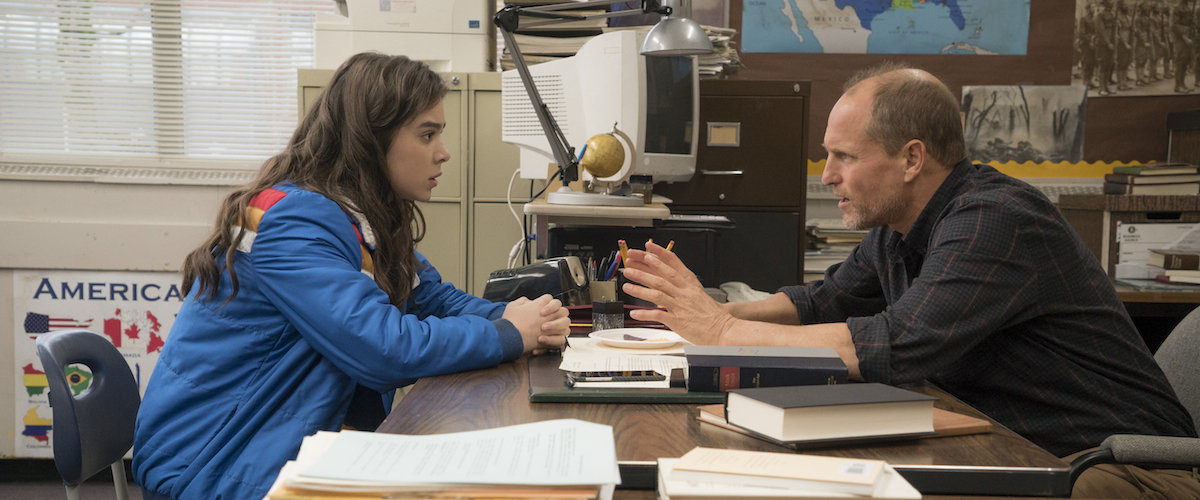- What Makes High School Movies Work? (Part 1)
- What Makes High School Movies Work? (Part 2)
High school movies span decades. There are thousands covering most of film and TV history. This is mainly for one reason: the themes in them are universal.
The stories of high school are the stories of life. Of joy, sadness, yearning, accomplishment, and all things in-between.
On The Edge of Seventeen is a prime example of the comedy and tragedy of being trapped in four years of constantly shifting realities.
We Can Relate
Who doesn’t know the anguish of unrequited love? It’s exhilarating and crushing all at once. Or the clueless parent(s)? The love/ hate relationship we have with siblings? Or the feelings of being on train going the wrong way that pursue you throughout those confusing teen years?
Through archetypal characters and motifs of which we’re familiar, we experience seventeen-year-old Nadine Franklin’s (Hailee Steinfeld) life at a point in time.
She basically has one true friend, Krista (Haley Lu Richardson). She lives with her mother, Mona, and her very popular brother, Darian, (Blake Jenner). Mona (Kyra Sedgwick) is raising the kids alone because her husband died of a heart attack. This was a father that Nadine adored and his death created a huge vacuum in her life and basically drove her inward. Currently, Nadine is nearing graduation and things are only getting worse.
In a truly funny turn, Woody Harrelson plays one of her teachers, Mr. Bruner, who is her adult-confessor when things spiral out of control, which happens on a pretty regular basis. His sarcastic tone when dealing with her puts her teen, melodramatic antics in context.
Nadine bursts into Mr. Bruner’s classroom, sits at a desk opposite of Bruner’s desk. She’s obviously distressed.
NADINE
(to Bruner)
Look, I don’t wanna take up a ton of your time…
But I’m gonna kill myself. I just thought that someone
should know.
(beat)
I don’t know how this works.
I’m probably gonna jump off an overpass in
front of a semi, so…Or a U-Haul. Not a bus.
I’m not gonna be a dick and make people watch.
But it has to be big. It’s gotta be so big
that it just…Done. Kills me. Lights out.
‘Cause if it just maims me and I’m like…
well, how’s that good for anyone?
Then I gotta find a nurse to smother me.
How am I gonna get across “smothering” if I’m…
(beat)
We don’t need to get caught up in the minutia.
I just thought that an adult… you should know.
MR. BRUNER
(sincere)
Wow. This is, uh, a lot to take in, Nadine.
I… I wish I knew what to say.
(thinking)
Well, I was actually just drafting my own
suicide note just now.
(picking up a sheet of paper)
“Dear everybody. As some of you know, I have thirty-two
fleeting minutes of happiness per school day during lunch,
which has been eaten up again and again by the same…especially
badly dressed student, and I finally thought, you know what?
I would rather have the dark, empty nothingness.
I really would. It sounds… relaxing. Have a nice life.”
This is from a transcript. An earlier version of the script called Besties is quite a bit different from the final movie and doesn’t appear to have a Bruner character in it. The addition is terrific and opens up Nadine’s circle of acquaintances wonderfully even extending to her ending up at his home with his wife and baby. Bruner acts as an oracle character, sarcastic but supportive and helpful.
In one scene, watching him play with his child you can see the yearning Nadine has for that sort of connection which emphasizes her lack of that in the present, presages her future, and touches back on her past when her father was alive and they were buds.
There’s also the lovable friend character who is in love with her, Erwin (Hayden Szeto), who she’s put in the ‘friend-zone.’
These solid archetypes and familiar situations create a solid base for a dramedy that delivers on the concepts that make a high school movie what it is and allows us to easily relate to it.

Deanie Feldstein and Kaitlyn Deaver in Booksmart. Photo courtesy of Annapurna Pictures
Transition(s)
Many high school films take place at a moment of transition. Upcoming graduation, sexual awareness, a contest, parents divorcing, etc. The way our educational system is set up, it’s a no-brainer. Each step to the senior class level is a time of growth and transition.
Book Smart, for example, is based in the final few months of high school for the characters and it is emotionally wrought for pals played by Kaitlyn Dever and Beanie Feldstein whose close relationship as besties is about to undergo a radical change.
In On The Edge of Seventeen, the upcoming moment of change isn’t so much the impending graduation as much as it’s an emotional shift for Nadine’s friend, Krista, who begins dating Nadine’s brother, Darian.
Nadine must learn to embrace the change in her friend which is causing them to drift apart. Nadine sees the dating of her brother as a betrayal. It’s growth, but not on Nadine’s part. And she can’t accept that her and Krista are no longer little girls (emotionally). She’s not ready to shed the preteen ‘skin’ she’s still living with, and the entire storyline gives us the painful confusion she’s experiencing.
This is when she meets Krista as a child.
NADINE (V.O.)
My childhood had become a raging dumpster fire,
and I couldn’t take one more second of this
intolerable, unliveable nightmare of a…
(beat)
And then, out of the clear blue, an angel appeared.
She was dressed like a small, elderly gentleman.
And her breath smelled of Sweetarts.
That formed the basis of a years-long friendship. And as the old saying goes, misery loves company so Nadine found identity with Krista until Krista decided to push into adulthood leaving Nadine somewhat alone.
Nadine now feels even more isolated than she’s ever been and even the attempts by her mother to help don’t help.
This shock to the system that’s present in different forms in most high school films is what creates growth as Nadine begins to question the very nature of her life. She’s growing albeit painfully.
Nadine is having the same thoughts as Krista, but she’s resisting the change that’s on the horizon.
NADINE (V.O.)
He (Nick) works at Petland now. I should go
in there and be like, excuse me, where are the beta fish?
Also, could you put your penis inside me?
(beat)
God. What if you actually did that? What if you
lost your virginity in a Petland? I think it’d be kind of nice.
All the little tropical fish watching. It’d be kind of spiritual.
This, in part is what makes high school movies so compelling. The fear of growth, the push-pull to adulthood; standing on the edge of a cathartic experience and being scared silly about the outcome. It’s some of the most powerful drama you can write because it’s an exposed, raw nerve and pulls no punches.

Main cast of Mean Girls. Photo courtesy of Paramount Pictures
Tribes
These groups (cliques) popularized by The Breakfast Club are the “typical” ones which have remained basically the same forever, and form a social structure in any film or TV series. They are used for their effects on the main characters either by being accepted into one or rejected by one. Either result being potentially ultimately disastrous.
Being a reflection of real life where we tend to gravitate toward common interests for support and safety, the power of cliques (tribes) can’t be underestimated.
In Mean Girls, Cady (Lindsay Lohan) is warned not to join the mathletes – it’s social suicide, she’s told. She’d be embraced by that group (maybe) but rejected by others. Edge Of Seventeen has cliques, but Nadine is never successful in being part of one so she ends up with Mr. Bruner as her tribe of one – well, two – although he clearly is wary of her lack of peer socialization.
Alienation
Another powerful theme in any high school film (or TV show) is the terrible alienation felt by the characters.
Glee utilizes this to solid effect in the first season as the Glee Club (geek tribe) members get Slushied by the ‘jocks’ on a daily basis. Bullying isn’t funny and is definitely a practice that shouldn’t occur but no school can really do away with it completely because of the cliques that form. Again, a microcosm of real life where people gravitate to shared interests and form relationships based on that mutuality.
Again, Nadine isn’t really in any clique which is also standard fare for these movies. She’s an outsider trying to rise above the nonsense she witnesses but it also creates a terribly alienated existence. When Krista finds a new relationship and Nadine can’t cope this allows the writer to show some pretty insightful and dramatic scenes of Nadine scrambling to find identity.
This all leads to eventual growth as the alienation she feels explodes and causes a breakdown. Really solid, if painful, drama.
Rejection Of Values
No teen in these movies apparently can like or tolerate their parents. Some scripts take pains to show what was and what is now. When we’re young we count on our parents. But that transition from preteen to teen is a rough one on parental and other relationships. Neither part of the equation knows how to handle it.
Nadine’s father died at a time in her life when she was vulnerable. There seems to be a consistent arc for characters like this who have been ‘betrayed’ by parents, friends, family (brothers, sisters, uncles, aunts) or society. This action forms a barrier to continued social development and causes the character to reject their foundational support which then extends to secondary tiers like different classmates, teachers, and other people.
You might think that Nadine is being overly-dramatic when she indicts and then rejects her friend Krista; but because of her severely limited social circle – Krista is her only real friend – she sees another person she loves abandoning her. Of course, we see this in all facets of life when one of our friends gets a significant other, and then doesn’t seem to have time for us.
This can also extend to other areas where an A-student suddenly begins failing or an athlete doesn’t show up for practices. In high school, the magnifying glass is focused so much more closely because there’s a set of rules specifically designed to promote achievement. People in general typically don’t watch you as much in college or in real life.
High school narrows the context so that a senior is being monitored by several sources and the failings, especially the scholastic or sports activities, set off alarms which then leads to some sort of confrontation.
In Edge Of Seventeen there isn’t this type of degradation of goals except in general as Nadine grows further and further away from her so-called normal life.

